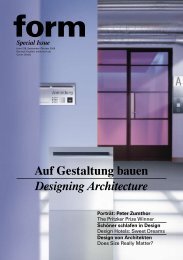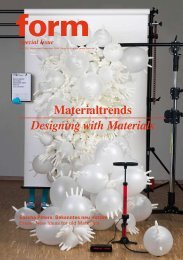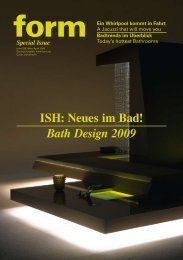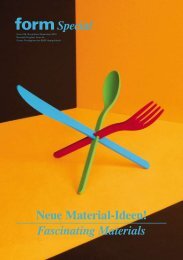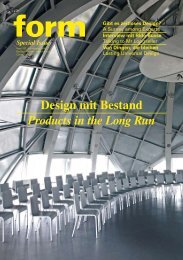Materialien für Designer The Magic of Materials - Creative Industries ...
Materialien für Designer The Magic of Materials - Creative Industries ...
Materialien für Designer The Magic of Materials - Creative Industries ...
Sie wollen auch ein ePaper? Erhöhen Sie die Reichweite Ihrer Titel.
YUMPU macht aus Druck-PDFs automatisch weboptimierte ePaper, die Google liebt.
10 <strong>Materials</strong><br />
Auf Spurensuche: Die Paneele von<br />
B.LAB Italia lassen Fußabdrücke<br />
hell leuchten (rechts), Kunstst<strong>of</strong>fe<br />
von IPS wechseln je nach Temperatur<br />
die Farbe (links), Beton wird<br />
lichtdurchlässig (unten) – Effekte,<br />
die beinahe magisch wirken.<br />
Tracking things down: <strong>The</strong> B.LAB<br />
Italia panels cause the footprints to<br />
light up (on the right), plastic by IPS<br />
changes its color depending on the<br />
temperature (on the left) – effects<br />
that almost seem magical. Below:<br />
light-permeable concrete.<br />
wechseln (<strong>Magic</strong>olor von IPS), Kunstleder, das bei<br />
Dehnung die Farbe wechselt (Dines), Paneele, die<br />
den Fußabdruck hell erleuchten lassen (B.LAB Italia)<br />
oder Kunstst<strong>of</strong>fe, die Wasser absorbieren und sich<br />
dabei ausdehnen (Industrial Polymers). Besonders<br />
<strong>für</strong> den Modebereich interessant sind auch hitzesensitive<br />
Anzugst<strong>of</strong>fe (Sommers Plastic Products), die<br />
unter Wärmeeinfluss einen leichten Farbstich er -<br />
zeugen. Der St<strong>of</strong>f wurde jüngst von Calvin Klein <strong>für</strong><br />
seine Herrenkollektion genutzt.<br />
In der Architektur wiederum spielen Glasfassaden<br />
eine immer wichtigere Rolle. Pr<strong>of</strong>itiert man<br />
im Winter von viel Licht und Wärme, ist ihre Durchlässigkeit<br />
<strong>für</strong> Strahlung im Sommer jedoch schnell<br />
unangenehm. Abhilfe versprechen hier Verbund gläser<br />
mit thermotropen Eigenschaften, die abhängig<br />
von der Lichteinstrahlung ihre Transparenz so wie<br />
ihre Reflexionseigenschaften verändern können.<br />
Das Fraunh<strong>of</strong>er IAP in Potsdam arbeitet momentan<br />
an thermotropen, hochreaktiven Gießharzen <strong>für</strong><br />
solch e Fens ter, die Solarstrahlung reflektieren – und<br />
zwar unsichtbar und ohne aufwendige Steuerung!<br />
Die Revolution der Materie hat gerade erst begonnen.<br />
<strong>Designer</strong> und Architekten sind jetzt aufgerufen,<br />
sich das Neue zunutze zu machen und die technischen<br />
Potentiale in sinnvolle Produkte zu überführen<br />
– als Demonstration gegen die Entmaterialisierung<br />
unseres Lebens.<br />
<strong>The</strong> world <strong>of</strong> products seems to have lost its material<br />
properties. Music, for example, was once<br />
pressed onto records and inserted into sleeves and<br />
is now experiencing almost no materiality between<br />
sale and playback. It is sold to us on the<br />
Interne t in digital form. And even mp3 players<br />
are now so small you can easily lose them in your<br />
breast pocket. Many different areas <strong>of</strong> our lives<br />
have long since become virtual, stripped <strong>of</strong> materials.<br />
In them, there is a perceptible distance to objects<br />
which our grandparents’ generation could<br />
neve r have imagined. With new electronic media,<br />
digital financial cash flows and the omnipresent<br />
Die neuen <strong>Materialien</strong> haben immer<br />
auch eine reaktive Seite, die<br />
sich erst bei der Nutzung <strong>of</strong>fenbart.<br />
Das Kunstleder von Dines etwa<br />
(links) wechselt bei Dehnung seine<br />
Farbe. Der Kunstst<strong>of</strong>f Hydrospan<br />
von Industri al Polymer s (rechts)<br />
kann Wasser absorbieren.<br />
availability <strong>of</strong> information the good old mechanized,<br />
tactile world would appear to have come to<br />
an end – something trend researchers have been<br />
predicting for years.<br />
But if you look at the diversity <strong>of</strong> new materials which<br />
were or will be presented at events this year such as<br />
Material Xperience by Materia in Utrecht, the Caméléon<br />
exhibition by Innovathéque in Paris (until September<br />
2009), Material Vision in Frankfurt (16 – 18 June, 2009)<br />
and not least <strong>of</strong> all in innumerable material libraries and<br />
data bases, material appears to be returning in full force.<br />
A paradox? Or perhaps the next step in the development<br />
<strong>of</strong> our product worlds?<br />
In addition to material components in the traditional<br />
sense, what material laboratories are currently<br />
churning out also has a virtual, intelligent side to it: Textiles<br />
respond to temperatures and change shape, stone<br />
becomes permeable allowing light to pass through, electro-active<br />
polymers expand in an electric field and will<br />
influence the characteristics <strong>of</strong> flying objects in the future,<br />
as morphing materials. This new material, let’s call<br />
it reactive material, has functions which first become apparent<br />
when actually used. Impressive future visions already<br />
have designers’ hearts beating faster as both the<br />
mechanized, long since outmoded understanding <strong>of</strong> materials<br />
and the virtual nature <strong>of</strong> our product world are being<br />
revolutionized by a new culture <strong>of</strong> materials.<br />
In this revolution, the creative agents <strong>of</strong> our world,<br />
designers and architects, are at the forefront. Who else<br />
should give a sensible application to an invisible function<br />
so it can be perceived by the user? Yvonne Chan Vili, for<br />
example, examined the use <strong>of</strong> textiles with interwoven<br />
wires made <strong>of</strong> shape memory alloys, for room dividers<br />
and wall hangings. Shape memory alloy materials record<br />
form information in their molecular structure. At low<br />
temperatures they can be sculpturally formed but when<br />
warmed, resume their original shape and determine the<br />
alignment <strong>of</strong> the material weave. Shape memory alloy<br />
textiles can be used in strong sunshine for example,<br />
to automatically darken rooms. <strong>The</strong> Dutch designers<br />
<strong>The</strong> new materials always have an<br />
intelligent and reactive side to them,<br />
too – something that does not emerge<br />
until they are used. Dines’ artificial<br />
leather, for example (on the left)<br />
changes color if stretched. Hydrospan<br />
plastic by Industrial Polymers<br />
(on the right) can absorb water.<br />
Frederik Molenschot and Susanne Happle are changing<br />
the urban image with an intelligent material: With a special<br />
surface coating they turn sober concrete stepping<br />
stones into a floral pattern when it rains. <strong>The</strong> hidden decoration<br />
only becomes apparent in public places and<br />
footpat hs when it is wet, establishing a new urban sign<br />
language. <strong>The</strong> new development named “Solid Poetry”<br />
was presente d by Droog Design back in 2006 at the<br />
Mila n Furniture Fair, and now the first construction with<br />
flower concrete has been completed in Eindhoven.<br />
That said, all <strong>of</strong> this seems to be just the beginning:<br />
<strong>The</strong> Innovathèque materials innovation center in<br />
Paris is now presenting a whole range <strong>of</strong> new creative<br />
materials at the Caméléon exhibition. Through September<br />
it will be presenting, among other things, plastics<br />
that change color according to ambient temperature<br />
(<strong>Magic</strong>olor von IPS), artificial leather which changes<br />
colo r when stretched (Dines), panels which light up<br />
footstep s (B.LAB Italia) and plastics which absorb water<br />
and expand (Industrial Polymers). Of particular interest<br />
to the fashion industry are heat-sensitive suit materials<br />
(Sommers Plastic Products), which change color slightly<br />
when warm. <strong>The</strong> material was recently used by Calvin<br />
Klein for his men’s collection. In architecture on the other<br />
hand, glass facades are playing an increasingly important<br />
role. In winter we benefit from more light and<br />
warmth but in summer the radiation which passes<br />
through glass can become unpleasant. Composite glass<br />
with thermotropical properties which can change its<br />
transparency and re flection properties depending on the<br />
light radiation <strong>of</strong>fers help here. <strong>The</strong> Fraunh<strong>of</strong>er IAP in<br />
Potsdam is working on thermotropical, highly reactive<br />
cast resin for windows which reflects solar rays – invisibly<br />
and without complex controls no less! <strong>The</strong> material<br />
revolution has only just started. <strong>Designer</strong>s and architects<br />
are called upon to make use <strong>of</strong> the new and to convert<br />
technical potential into sensible product worlds – in a<br />
demonstration against the immateriality <strong>of</strong> our lives.<br />
www.modulor.com<br />
<strong>Materials</strong> 11


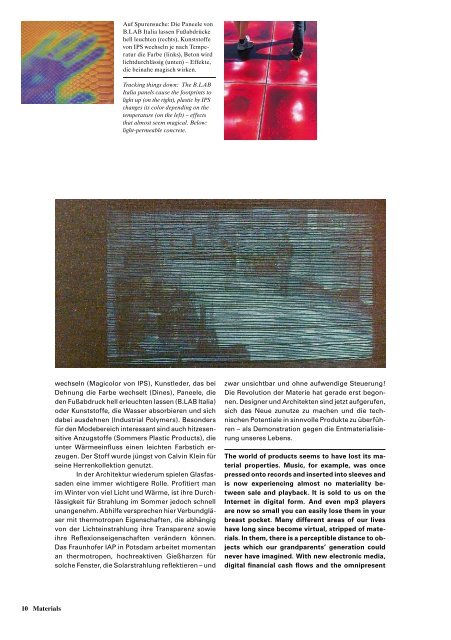
![[pdf - 2.18 MB] Sonderheft zur ISH - Form](https://img.yumpu.com/11048003/1/184x260/pdf-218-mb-sonderheft-zur-ish-form.jpg?quality=85)

